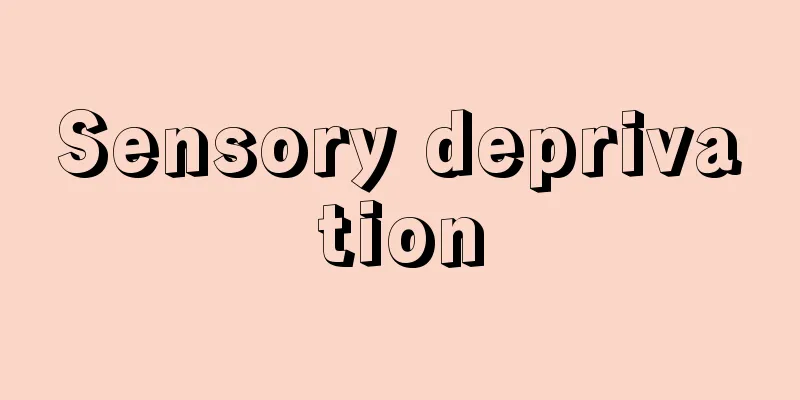Sensory deprivation

|
Sensory deprivation refers to the restriction or reduction of stimuli entering the sensory organs of the entire body, as well as the psychological state of an animal or human in such a situation. Sensory deprivation does not necessarily mean blocking all the senses, but also includes blocking only certain senses. Research into sensory deprivation began in the second half of the 20th century, first from a perceptual perspective, then from the perspective of brainwashing and mind control, and only in the 21st century has research begun into its significance as a form of psychotherapy. People engaged in monotonous tasks such as radar monitoring or monotonous long-distance driving may experience abnormal sensations, such as hallucinations. The Canadian Department of National Defense became interested in this phenomenon and asked Dr. Hebb, DO, of McGill University in Canada, to investigate it. Hebb began his research in 1955, in which he had participants lie on a bed, put cardboard tubes over their hands to prevent them from touching objects directly, covered their eyes, and played white noise (noise with a uniform frequency characteristic) to their ears to minimize external sensations. This state is called perceptual isolation. Although it was possible for them to eat and defecate, the participants were instructed to do nothing and relax at other times. Doing nothing and relaxing seems like an ideal state, but in reality, it was an abnormal situation in which there were no external stimuli, and various problems arose for the participants. The four phenomena reported in early studies were: (1) experiencing hallucinations, (2) becoming more susceptible to persuasion (i.e., increased suggestibility), (3) decreased cognitive performance, and (4) participants not wanting to continue and wanting to stop immediately. Hebb's research was published not only in academic papers but also in general papers, and many researchers became interested in this issue, especially the occurrence of hallucinations. Research methods also became more diverse, such as experiments in which participants were suspended in a tank of water to create sensory deprivation. In the 1960s, these types of experiments came to be called sensory deprivation experiments. Vernon, J. of Princeton University elaborated on this type of research and conducted systematic research, showing that hallucinations (1) are experienced by a minority of people. Hebb played white noise to block auditory stimuli, but later research suggested that this white noise may be a factor in inducing hallucinations. Regarding suggestibility (2), it has been shown that sensory deprivation can increase suggestibility, but that this is not a simple effect as it is also related to personal characteristics. One experiment showed that when sensory deprivation was performed on people with a neutral attitude toward Turkey and they were given favorable information about Turkey, their attitude toward Turkey changed to a more favorable one compared to people who did not undergo sensory deprivation. It has been shown that sensory deprivation increases suggestibility, which suggests that sensory deprivation is related to brainwashing and mind control. Brainwashing is a process that aims to (1) thaw (shake up and break), (2) transform (instill new ideas), and (3) refreeze (fix) a person's ideas. The person is physically restrained, external information is minimized (i.e., creating a sensory deprivation situation) and only biased information is given. Sometimes drugs are administered to control the mental state. It is said that in the 1950s, the Chinese Communist Party carried out this method on American prisoners of war during the Korean War with the aim of establishing favorable beliefs toward the Communist Party, and in the United States, Lifton, RJ and others conducted research by interviewing returning American soldiers. However, some research reports have shown that while it is possible to change people's behavior, it is difficult to change their ideas. Mind control also seeks to change an individual's values, but does not involve physical restraints. In other words, it does not physically or explicitly deprive the senses. However, it is similar in that it psychologically isolates the subject, blocks incoming information, and presents only biased information. Brainwashing and mind control are independent of the good or bad of the ideology and values that are the aim of change. However, mind control in particular is often carried out by anti-social cult groups, so it is often perceived as a negative act. Lilly, JC (1977) pointed out that a state of sensory deprivation has the effect of releasing muscle tension and is effective as stress management. Suedfeld, P. (1980) coined the term restricted environmental stimulation therapy (REST) as an alternative to sensory deprivation, paving the way for its clinical practice. A box-shaped device that allows sensory deprivation for relaxation has also been developed, and its effectiveness is being examined. In 2005, Dierendonck, DV and Nijenhuis, JT conducted a meta-analysis (a type of statistical analysis that aims to derive reliable results from the results of multiple studies) of 25 sensory deprivation studies (total number of participants: 449) conducted between 1983 and 2002. The results showed that it was effective against burnout syndrome and chronic fatigue. →Mind Control [Sato, Tatsuya] Latest Sources Psychology Encyclopedia Latest Psychology Encyclopedia About Information |
|
感覚遮断とは,全身の感覚器官に入る刺激を制限し,限りなく低減させること,およびそのような状況にある動物や人間の心理状態を表わす。感覚遮断には,すべての感覚を遮断するのではなく,ある特定の感覚だけを遮断することも含まれる。 感覚遮断に対する研究は20世紀後半に始まったが,まずは知覚的な観点からの研究が行なわれ,次は洗脳,マインド・コントロールという観点からの研究が行なわれ,21世紀に入ってからは,その心理療法としての意義が研究されるようになったといえる。 単調なレーダー監視や単調な長距離運転などに従事する人が,幻覚のような異常な感覚を経験することがある。カナダ国防省はこの現象に関心をもち,カナダのマクギル大学のヘッブHebb,D.O.に,この現象の精査を依頼した。ヘッブは1955年に研究を始めたが,そこでは実験参加者をベッドの上に横たわらせ,手には段ボール製の筒をかぶせて直接物に触ることのないようにし,目は覆い,耳には白色雑音(均一な周波数特性をもつ雑音)を聞かせるなどして外からの感覚を最小限にした。このような状態を知覚的分離perceptual isolationという。食事や排泄は可能だが,それ以外の時間,実験参加者は何もせずにリラックスしているようにと指示された。何もしないでゆっくりするというのは理想的な状態であるように思われるが,実際には,外からの刺激が何もないという異常な事態であり,実験参加者にはさまざまな問題が生じた。初期の研究によって報告された現象は,⑴幻覚を経験する,⑵説得されやすくなる(暗示にかかりやすい度合い,すなわち被暗示性suggestibilityが高まる),⑶認知的能力が低下する,⑷実験参加者は継続を望まず,すぐにやめたいと申し出る,の四つであった。 ヘッブの研究は学術論文のみならず,一般的な論文としても発表され,多くの研究者がこの問題,とくに幻覚が生じるということに関心をもつようになった。研究の方法も多様化し,たとえば実験参加者を水槽の中に浮かせることで感覚遮断をつくりだすという実験も行なわれるようになった。そして1960年代には,こういった実験を感覚遮断実験sensory deprivation experimentとよぶようになった。 このような研究を精緻化し,体系的な研究を行なったのはプリンストン大学のバーノンVernon,J.であるが,彼は,⑴の幻覚について,幻覚が生じるのはむしろ少数派であることを示した。ヘッブは聴覚刺激を遮断するために白色雑音を聞かせたが,この白色雑音が幻覚の誘発因となっている可能性が,後の研究で示唆されている。⑵の被暗示性については,感覚遮断が被暗示性を高め得ること,しかし個人特性などとも関連するため単純な効果ではないことが示されている。トルコに対して中立的な態度をもつ人に感覚遮断を行ない,トルコに好意的な情報を与えたところ,感覚遮断を行なわなかった人に比べて,トルコへの態度が好意的に変化することを示した実験などがある。 感覚遮断は被暗示性を高めることを示したが,このことは,感覚遮断が洗脳やマインド・コントロールに通じるものであることを示唆している。洗脳brainwashingとは,人がもっている思想を,⑴解凍し(ゆさぶりをかけて壊す),⑵変革し(新しい思想を吹き込む),⑶再凍結する(固定化する)ことを目的として行なわれるプロセスである。人を身体的に拘束し,外部からの情報を最小限にして(つまり感覚遮断の状況をつくりだし)偏った情報だけを与える。薬物を投与して精神状態をコントロールして行なうこともある。1950年代に中国共産党が朝鮮戦争におけるアメリカ兵捕虜などに対して,共産党への好意的信念の確立を目的として行なったとされ,アメリカではリフトンLifton,R.J.らが,帰国したアメリカ兵に対し面接を行なうなどして研究を進めた。ただし,人の行動は変化させることはできても,思想を変革することは難しいという研究報告もある。 マインド・コントロールmind controlも,個人の価値観などを変革しようとするものであるが,身体拘束は行なわない。つまり,物理的・明示的に感覚遮断を行なうことはない。それでも対象者を心理的に孤立させ,入ってくる情報を遮断し,偏った情報のみを提示するという点では同様である。洗脳やマインド・コントロールは,本来ならば変革の目的とされる思想・価値観のよしあしとは独立である。しかし,とくにマインド・コントロールは反社会的カルト集団によって行なわれることが多いため,否定的な行為と受け取られることが多い。 リリーLilly,J.C.(1977)は,感覚遮断の状態が筋肉の緊張をほどくなどの効果をもち,ストレスマネージメントとして効果的であることを指摘した。また,スウェドフェルドSuedfeld,P.(1980)は,感覚遮断に代わる,制限された環境刺激療法restricted environmental stimulation(REST)という用語をつくりだし,臨床的な実践への道を開いた。リラックス効果のための感覚遮断を可能にする箱形設備も開発され,効果の検討も行なわれている。2005年,ディレンドンクDierendonck,D.V.とニジェンフスNijenhuis,J.T.は,1983年から2002年までに行なわれた25の感覚遮断研究(総参加者数449人)に対するメタ分析(複数の研究成果から信頼性の高い結果を導きだすことをめざす統計的分析法の一種)を行なった。その結果によれば,燃え尽き症候群や慢性疲労に対する効果が認められたとのことである。 →マインド・コントロール 〔サトウ タツヤ〕 出典 最新 心理学事典最新 心理学事典について 情報 |
Recommend
Zenkoji earthquake
The earthquake occurred at around 9:00-10:00 pm o...
Stone Blade Arrowhead Culture
A culture characterized by stone blade arrowheads,...
Older sister doll - Older sister doll
〘 noun 〙 A type of toy for girls. A Hina doll in t...
Publishers Association
…The person who most sincerely tried to realize t...
Fjalarr
…Kvasir traveled the wide world, imparting wisdom...
Which one is better?
A Christian catechism used by Christians. The titl...
Irihama salt fields - Irihama salt fields
...According to old maps from the early 17th cent...
Marqués de Santillana (English spelling)
...Don Juan Manuel, the nephew of the wise king, ...
Crisis - Kiki
… Born into a pastor's family, he began his a...
Tsuneyoshi Yoshikawa
...A medieval samurai family from Suruga. The fam...
Miiro
…It is believed to be a transliteration of the Sa...
Kinosternon
…However, these aquatic species are not very dang...
speech organ
...The parts of these organs used to produce soun...
《Ikuta Atsumori》 - Ikuta Atsuri
…The two volumes of the extant picture scroll Koa...
Tone deaf - Onchi
A slang term used to mean someone who is not good...









